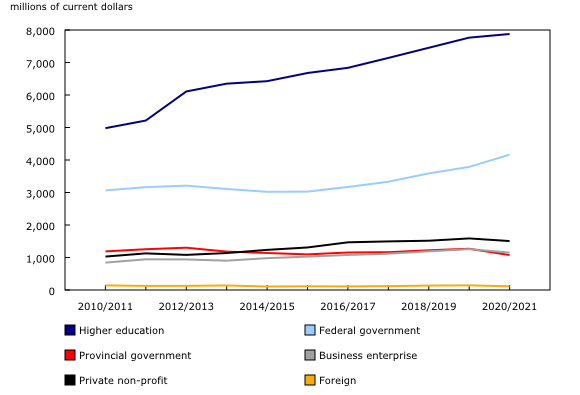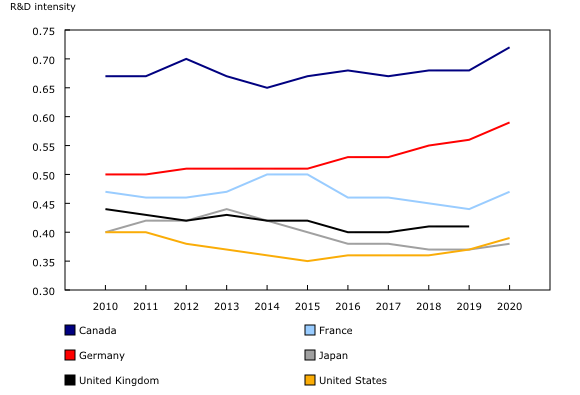Spending on research and development in the higher education sector, 2020/2021
Released: 2022-12-09
$15.9 billion
2020/2021
0.5% 
(annual change)
The higher education sector is an integral part of Canada's innovation economy and is responsible for a significant portion of the overall research and development (R&D) performed in Canada. While businesses often focus their R&D on specific interests, higher education institutions cast a broader net by performing R&D across a wide range of disciplines. The results of their findings often serve as key inputs in various industries and are sometimes leveraged to develop new products and services and achieve productivity gains.
Canada's higher education institutions also share critical knowledge with the community at large and thus are an important contributor to the health of Canada's innovation economy.
In 2020/2021, R&D expenditures by the higher education sector in Canada edged up 0.5% from 2019/2020 to $15.9 billion. This increase represented the 11th consecutive annual gain.
Federal government and own funds boost research and development spending
Several streams funded higher education R&D, from the institutions themselves, federal government grants, collaborations with businesses in various industries, and non-profit institutions. In 2020/2021, about half of all funding was generally attributable to the institutions themselves and more than one-quarter to federal grants.
In 2020/2021, higher education R&D rose on the strength of increased funding from the federal government (+9.9% to $4.2 billion) and own funds used by higher education institutions (+1.4% to $7.9 billion).
The $4.2 billion in funding from the federal government represented their largest financial contribution to higher education R&D since 2000. Three agencies administered the majority of these funds: Natural Science and Engineering Research Council, Social Sciences and Humanities Research Council, and the Canadian Institutes for Health Research.
Research and development spending down in natural sciences and engineering
R&D spending was predominantly intended for the natural sciences and engineering field of research, which has been more than three times higher than that for social sciences at varying points in the past. Despite this, spending within natural sciences and engineering fell 0.4% to $11.9 billion, marking its first decline since 2013/2014. The drop was mainly attributable to decreased funding from provincial governments (-$154.7 million to $860.5 million) and business enterprises (-$103.6 million to $1.1 billion).
By contrast, R&D spending in the social sciences field of research rose $123.1 million to $4.0 billion in 2021/2022. This rise in expenditures was tied to funding from the federal government (+$123.7 million to $860.1 million) and the higher education sector itself (+$76.0 million to $2.6 billion).
Ontario, Quebec and Saskatchewan lead the gain in research and development spending
Geographically, the increase in R&D spending in 2020/2021 was primarily concentrated in Ontario (+$238.4 million to $6.5 billion), followed by Quebec (+$62.9 million to $4.1 billion) and Saskatchewan (+$18.5 million to $419.9 million). These increases were enough to offset decreases in other regions, such as British Columbia (-$122.7 million to $1.8 billion), Alberta (-$72.6 million to $1.6 billion) and Newfoundland and Labrador (-$26.9 million to $356.5 million).
The federal government was largely responsible for R&D funding gains in Ontario, Quebec and Saskatchewan.
Canada continues to be a world leader in higher education spending
The benefits of academic research are enormous, from medical breakthroughs to innovative technologies. Over the years, Canada (0.72%) has remained the country with the highest higher education R&D intensity (higher education R&D expenditures per nominal Gross Domestic Product) among G7 countries.
In 2020/2021, Canada also ranked among the top five Organisation for Economic Co-operation and Development (OECD) member countries with the highest higher education R&D expenditures, ranking fourth, after Denmark, Sweden and Norway.
Note to readers
Concepts for expenditures on research and development in the higher education sector
The higher education sector is composed of all universities, colleges of technology, and other institutions that provide formal tertiary education programs, as well as all research institutes and centres, experimental stations, and clinics that are operated under the direct control of higher education institutions.
Higher education research and development (HERD) is a large component of Canada's overall gross expenditures on research and development (R&D). Science and technology (S&T) activities conducted by higher education institutions produce knowledge that seeds innovations in the other performing sectors of the economy. Moreover, HERD spending increases the capacity of S&T activities that researchers are able to perform in all sectors of the Canadian economy.
Total expenditures on R&D are classified into two fields of science: natural sciences and engineering and social sciences, humanities and the arts.
There are six funding sources for R&D expenditures in the higher education sector: business enterprises, private non-profit organizations, the federal government, provincial governments, the foreign sector and internal funding from the higher education sector.
The R&D intensity of a country is the ratio of R&D expenditures to gross domestic product (GDP). This can also be calculated for the sectors of a country's economy. This indicator facilitates comparisons both over time and between countries.
With the release of data for the reference period 2019/2020, previously released data from 2010/2011 to 2018/2019 have been revised.
For further information on concepts and definitions relating to R&D expenditures in the higher education sector, please see this release's "Related information" tab.
References
OECD. (2015). Frascati Manual 2015: Guidelines for Collecting and Reporting Data on Research and Experimental Development, The Measurement of Scientific, Technological and Innovation Activities, OECD Publishing, Paris.
OECD Science, Technology and Innovation Scoreboard. (2021). On this page, search for "HERD as a percentage of GDP" under "Gross Domestic expenditures on R&D by performing sector."
Contact information
For more information, or to enquire about the concepts, methods or data quality of this release, contact us (toll-free 1-800-263-1136; 514-283-8300; infostats@statcan.gc.ca) or Media Relations (statcan.mediahotline-ligneinfomedias.statcan@statcan.gc.ca).
- Date modified:


